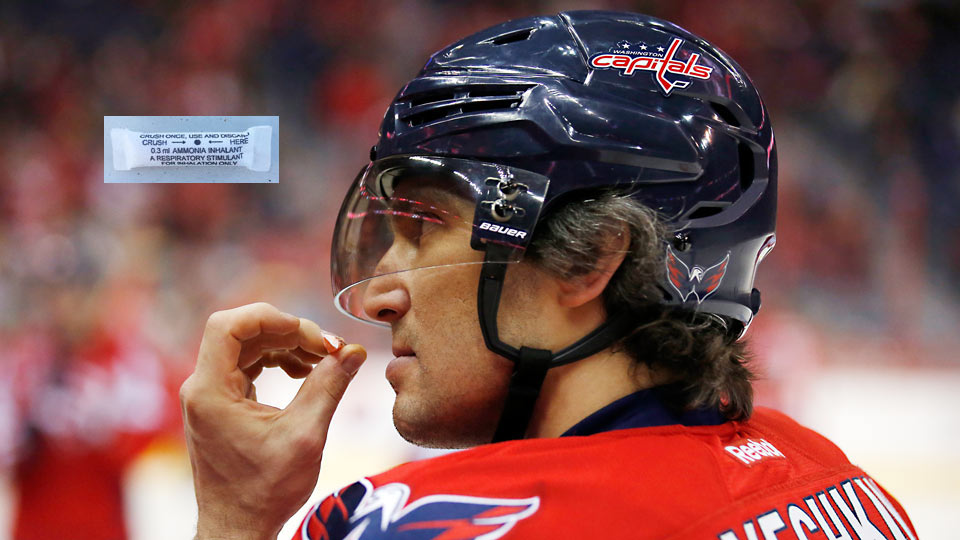SMELLING SALTS
Updated 04-May-2020.
Mondo shtuff from around the internet, all about SMELLING SALTS!
 Why Do Smelling Salts Wake You Up? – Jump Start: If you’ve ever wondered why smelling salts work the way they do, then this is the post for you. If you could care less about the technical, scientific aspects of these ammonia salts, then steer clear. Either way, I’ll try and be brief in my explanation. How Smelling Salts Work Smelling salts mostly work by …
Why Do Smelling Salts Wake You Up? – Jump Start: If you’ve ever wondered why smelling salts work the way they do, then this is the post for you. If you could care less about the technical, scientific aspects of these ammonia salts, then steer clear. Either way, I’ll try and be brief in my explanation. How Smelling Salts Work Smelling salts mostly work by …
 Smelling salts jolt of choice in NHL: A vile vial of pungent chemicals, smelling salts are a pregame ritual for NHL players and coaches.
Smelling salts jolt of choice in NHL: A vile vial of pungent chemicals, smelling salts are a pregame ritual for NHL players and coaches.
 Smelling Salts | Definition of Smelling Salts by Lexico: What does smelling salts mean? smelling salts is defined by the lexicographers at Oxford Dictionaries as A pungent substance sniffed as a restorative in cases of faintness or headache, typically consisting of ammonium carb…
Smelling Salts | Definition of Smelling Salts by Lexico: What does smelling salts mean? smelling salts is defined by the lexicographers at Oxford Dictionaries as A pungent substance sniffed as a restorative in cases of faintness or headache, typically consisting of ammonium carb…
 Smelling salts: What’s in a name? That which we call a rose
By any other name would smell as sweet
William Shakespeare (1564–1616)
Romeo and Juliet: act 2, scene 2
Smelling salts: What’s in a name? That which we call a rose
By any other name would smell as sweet
William Shakespeare (1564–1616)
Romeo and Juliet: act 2, scene 2
I was delving into some reference material recently, trying to track down details of early treatment of mild head injury, and I was struck by the repeated mention of smelling salts as a folk remedy for this problem. But just what are smelling salts? Do they work and can they cause injury?
Although smelling salts have recently undergone a resurgence of interest by athletes as a pre-game stimulant or as a “pick me up” when performance is flagging, it appears that little is really known or understood about these agents. Over time they have tended to remain a traditional part of the trainer’s kit (along with the ubiquitous sponge and cold sprays) rather than in the medical bag.
In the setting of sporting head injury, there are still many individuals and organisations that recommend the use of smelling salts to try and revive the injured athlete. Most recent sports medicine textbooks, however, emphatically state that smelling salts are contraindicated as they cause a withdrawal reaction, with the potential to cause or exacerbate spine injury.
Take, for example, this early guideline for the management of unconscious patients from The treatment to restore natural breathing and circulation published in 1878 by Dr Peter Shepherd, Surgeon Major, Army Medical Department and an Associate of the Order of St John of Jerusalem. His approach was fairly dogmatic:
Rule 1 – “To Maintain a Free Entrance of Air into the Windpipe – Cleanse the mouth and nostrils; open the mouth; draw forward the patient’s tongue, and keep it forward: an elastic band …
My botty best at summarizing from Wikipedia: ammonia inhalants, spirit of hartshorn and sal volatile are chemical compounds often used to arouse consciousness . historically, smelling salts have been used on people feeling faint, or who have fainted evidence exists of use in the 13th century by alchemists as sal ammoniac . they were widely used in Victorian Britain to revive fainting women . the use of smelling salts was widely recommended during the Second smelling salts produce only a small amount of ammonia gas . no adverse health problems have been reported from their situational use . the use of scented salts to revive people injured during sport is not recommended .